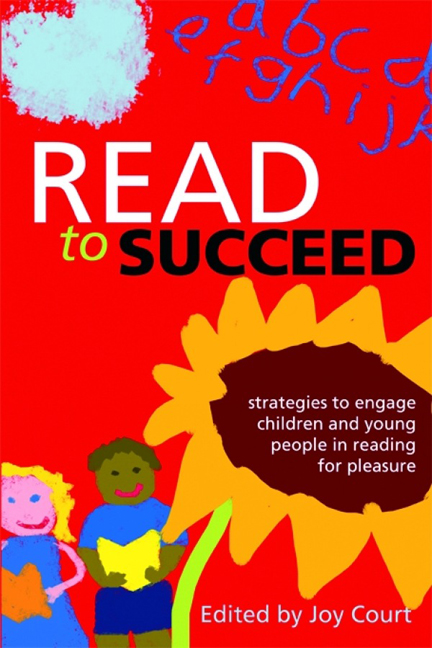Book contents
- Frontmatter
- Dedication
- Contents
- Foreword
- Contributors
- Introduction
- 1 It's never too soon to start
- 2 How children begin to read
- 3 Creating young readers: teachers and librarians at work
- 4 The six dimensions of the ‘honeycomb’ model, and its implications for literacy, libraries and literature in New Zealand
- 5 The Summer Reading Challenge in libraries: a continuing success
- 6 Stockport does Book Idol! A case study linking libraries and schools to inspire reading for pleasure
- 7 There and back again: restoring reading to the classroom
- 8 Promoting excellence: shadowing the CILIP Carnegie and Kate Greenaway Medals
- 9 Choice and motivation: local book awards
- 10 The sport of reading
- 11 Adventures in the book trade: libraries and partnerships
- 12 The hard-to-reach reader in the 21st century
- 13 Creative reading and insideadog.com.au
- Index
- Miscellaneous Endmatter
- Miscellaneous Endmatter
- misc-endmatter
13 - Creative reading and insideadog.com.au
Published online by Cambridge University Press: 08 June 2018
- Frontmatter
- Dedication
- Contents
- Foreword
- Contributors
- Introduction
- 1 It's never too soon to start
- 2 How children begin to read
- 3 Creating young readers: teachers and librarians at work
- 4 The six dimensions of the ‘honeycomb’ model, and its implications for literacy, libraries and literature in New Zealand
- 5 The Summer Reading Challenge in libraries: a continuing success
- 6 Stockport does Book Idol! A case study linking libraries and schools to inspire reading for pleasure
- 7 There and back again: restoring reading to the classroom
- 8 Promoting excellence: shadowing the CILIP Carnegie and Kate Greenaway Medals
- 9 Choice and motivation: local book awards
- 10 The sport of reading
- 11 Adventures in the book trade: libraries and partnerships
- 12 The hard-to-reach reader in the 21st century
- 13 Creative reading and insideadog.com.au
- Index
- Miscellaneous Endmatter
- Miscellaneous Endmatter
- misc-endmatter
Summary
Introduction
We all know that reading is important, especially when it comes to children. But what do we actually mean by reading? Do comic books count? Newspapers? Goosebumps books? What about the internet?
Australia's Centre for Youth Literature promotes reading for pleasure, through a variety of onsite, offsite and online programs. The primary principle underlying the Centre for Youth Literature programme is access. Within the limitations of current resources, the Centre aims to maximize geographic, social and cultural access to its programme, which of course is greatly expanded through our online programmes, namely the Boys Blokes Books and Bytes blog (boysblokesbooks.edublogs.org), our Read Alert blog for professionals (slv.vic.gov.au/readalert), and, in particular, Inside a Dog (www.insideadog.com.au), our website for young people about books and reading.
The Centre sits within the State Library of Victoria as part of the Library's youth offer. The State Library strives to provide access to Victorian, Australian and international resources that will enrich young people's cultural, educational, social and economic lives. Its work in achieving these values is informed by the five values of innovation, collaboration, engagement, excellence and respect. Inside a Dog is part of the Library's online offer which, in addition to a corporate site, also includes Ergo – a research skills website and an ongoing digitization project featuring images and manuscripts. The Library also works closely with the State Government Department of Education to develop and manage a series of educationbased web projects in partnership with a number of other cultural institutions.
Why read?
Reading brings many more benefits than just improved literacy skills. The rewards of a love of reading last a lifetime: well-being, resilience, communication skills, personal development, imagination, creativity, curiosity.
The Search Institute in the US (Search Institute, 2007) lists 40 developmental assets for young people to make them become caring, responsible adults. The more assets a young person has, the more likely they are to succeed in school, help others, value diversity, maintain good health, resist danger, exhibit leadership and overcome adversity. They are also less likely to use drugs or alcohol, vandalize, choose violence, skip school or become depressed and/or suicidal. One of the key assets is Reading for Pleasure, which goes hand in hand with related assets such as Creative Activities, Community Values Youth and School Engagement.
- Type
- Chapter
- Information
- Read to SucceedStrategies to Engage Children and Young People in Reading for Pleasure, pp. 225 - 238Publisher: FacetPrint publication year: 2011

